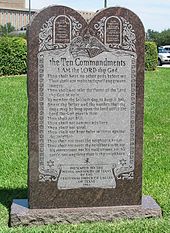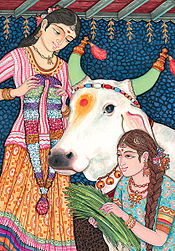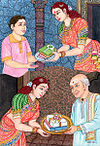- Orthopraxy
-
 A building in Hong Kong with a hollow middle hole, maximizing on fengshui benefits.
A building in Hong Kong with a hollow middle hole, maximizing on fengshui benefits.
Orthopraxy is a term derived from Greek ὀρθοπραξία (orthopraxia, meaning "correct action/activity") or an emphasis on conduct, both ethical and liturgical, as opposed to faith or grace etc.[1][2][3] This contrasts with orthodoxy, which emphasizes correct belief, and ritualism, the use of rituals.[4]
While orthodoxies make use of codified beliefs, in the form of creeds, and ritualism more narrowly centers on the strict adherence to prescribed rites or rituals, orthopraxy is focused on issues of family, cultural integrity, the transmission of tradition, sacrificial offerings, concerns of purity, ethical systems, and the enforcement thereof.[5][6] Typically, traditional or folk religions (paganism, animism) are more concerned with orthopraxy than orthodoxy, and some argue that equating the term "faith" with "religion" presents a Christian-biased notion of what the primary characteristic of religion is. In the case of Hinduism orthopraxy and ritualism are mixed to the point that they become a single identity.
Contents
Christianity
Main articles: Christian ethics and Good worksSee also: New Perspective on PaulThough traditionally Christianity is seen as primarily orthodoxical (as in the Nicene Creed's "I believe in ..."), some Christian denominations and leaders today, from Roman Catholic to Evangelical Christians, have started to describe their religions as both orthodoxical and orthopraxic. The premise is "correct belief" compels "correct action," and incorrect action is caused by incorrect beliefs.[7][8]
Taking this combination of "correct belief" and "correct action" a step further, Prosperity theology, found in charismatic and Pentecostal traditions, teaches correct religious belief and behavior receives material reward and physical healing, in addition to being a necessary component for accepting God's Grace. Prosperity theology is a concept known as reciprocity when discussing traditional or ethnic religions such as that in Ancient Greece, but is limited to correct behavior over any one theological idea.[9]
The purpose of Divine law is disputed among Christian denominations. A minority are Torah-observant, sometimes called Jewish Christians, and at the other extreme are antinomistic and anarchistic views. In between, most Christians believe that some or all of the Ten Commandments are still binding or have been reinstituted in the Law of Christ. For the teachings of Jesus on the subject, see Ministry of Jesus – Teachings, Sermon on the Mount, and Counsels of perfection.
Eastern Christianity
Main article: Praxis (Eastern Orthodoxy)See also: Orthodox ChurchOrthopraxis would include attendance of church services which are designed to benefit the practitioner of the Eastern Orthodox faith.[dubious ] It refers to accepted religious practices and may include both ritual practices as well as interpersonal acts. The Orthopraxy ties into the concept of Phronema and is meant to work together toward the goal of theosis.[citation needed]
Judaism
Circle U indicates this product is certified as kosher by the Orthodox Union. Shema Yisrael (שמע ישראל) Recitation
Shema Yisrael (שמע ישראל) Recitation
Judaism is primarily orthopraxic[citation needed], with obedience to its laws being the mark of an "observant Jew." However certain laws/commandments of the Torah require the acceptance of certain basic beliefs, such as the first and second Positive commandments in Maimonides' Sefer Hamitzvot, which mandate the belief in God and His indivisible unity, or the recitation of the Shema. Thus, describing Judaism solely in orthopraxic terms is not accurate. Additionally, Maimonides' codification of Jewish law (the Mishneh Torah) contains a section entitled Yesodei HaTorah which delineates the legally required beliefs of Judaism, further bolstering the contention that praxis alone is insufficient.
Islam
 A package of halal-certified (see green label on the package) frozen food (steamed cabbage buns) from Jiangsu province, China
A package of halal-certified (see green label on the package) frozen food (steamed cabbage buns) from Jiangsu province, China
The Five Pillars of Islam fundamental to Sunnis prescribe Islamic practice, while Shahadah (profession of faith) defines Islamic belief. Generally stresses Orthopraxy over Orthodoxy, but since the practice is held to come from doctrine, this is essentially orthodoxy applied to practice.
Hinduism
See also: DharmaIn the case of Hinduism orthopraxy and ritualism are conflated. Emphasis on ritual vs. personal salvation (moksha) was a major division in classical Hindu philosophy, epitomized by Purva Mimamsa vs. Uttara Mimamsa (Vedanta).
Ritual (puja) continues to play a central role in contemporary Hinduism, but the enormous complexity of ancient ritual (yajna) only survives in a tiny minority of Shrauta practitioners. Even Hindus who diligently practice a subset of prescribed rituals are called orthoprax, to contrast them with other Hindus who insist on the importance of correct belief or understanding. The correctness of one's interpretation of the scripture is then considered less important than following traditions. For example, Srinivasa Ramanujan was a well-known example of an orthoprax Hindu.
In terms of "proper conduct" and other ethical precepts within the Hindu framework, the core belief involves the divinity of each individual soul (jivatma). Each person harbors this "indwelling God (divinity)"; thus, conduct which unifies society and facilitates progress is emphasized. Self-centered existence is discouraged as a result of this jivatma concept. Interestingly, it's the Uttara Mimamsa philosophical school which seems to explicate this concept so eloquently. Moreover, within the context of Uttara Mimamsa the role of puja (ritual) also involves bringing the individual jivatma closer to the Paramatma (the Transcendent Divinity or God). Individuals who have attained this merging then become the spiritual guides to the community. Later developments within the Hindu religious and philosophic tradition thus try to unify these concepts of ritual, proper conduct, and personal salvation instead of leaving them in mutually conflicting terms. The movement inspired by Pandurang Shastri Athavale termed Swadhyaya seems to be one manifestation of this syncretism. However, other movements within the contemporary Hindu scene are also moving towards this union of external activity and internal development.
Jainism
See also: Jain philosophyJain orthopraxy is based on two factors: Jain siddhanta (teachings of the Tirthankara) and kriya (practices prevalent at the time of the Tirthankaras). According to Jains, the Tirthankaras based their teachings and philosophy after knowing the realities on this universe (like dravya and tattva). Based on these realities, they propounded true and eternal principles like ahimsa, truth, karma etc. that govern the universe. Jain rituals were codified on the basis of these principles to give effect to the teachings of the Tirthankaras.
Taoism
Main article: TaoismNeopaganism
British Traditional Wicca is highly orthopraxic, with "traditions" (as denominations in Wicca are called) being precisely that—defined by what is traditionally done, rather than shared beliefs.[10] Other Neopagans may or may not share this quality, as noted by James R. Lewis, who draws a distinction between "Religious Neo-Pagans" and "God/dess Celebrants." Lewis states the majority of the Neopagan movement is strongly opposed to Religionist traditions that incorporate any form of orthopraxy or orthodoxy.[11] In fact, many Neopagan organizations, when discussing orthopraxy, limit themselves solely to ritualism.[12]
Polytheistic Reconstructionism
Polytheistic Reconstructionism, such as Hellenismos, provides a stark contrast to popular Neopaganism, being more conservative in nature.[neutrality is disputed] These movements seek to revive traditional pre-Christian religions adapted to the modern world, but with an adherence to the values and ethical systems of the ancient cultures, loyalty and reverence toward specific pantheons, and by promoting traditional interpersonal obligations associated with the family, community, and society. Reconstructionist religions make full use of orthopraxy, defining their practices as a lifestyle, and identifying "correct action" as living life in accord with specific ideals and principles,[13][14][15][16][17] rather than focusing solely on ritual or promoting a single cosmology, metaphysical idea, or theological theory as absolute truth.[18]
See also
- Cambridge Ritualists
- Kalpa (ritual)
- Mimamsa
- Praxis (Orthodox)
- Ritualism
Notes
- ^ Jackson, Elizabeth (2007). The Illustrated Dictionary of Culture. Lotus Press. pp. 147. ISBN 978-8-1890-9326-6.
- ^ Westley, Miles (2005). The Bibliophile's Dictionary. Writer's Digest Books. pp. 91. ISBN 978-1-5829-7356-2.
- ^ McKim, Donald K. (1996). Westminster Dictionary of Theological Terms. Westminster John Knox Press. pp. 197. ISBN 978-0-6642-5511-4.
- ^ McKim, Donald K. (1996). Westminster Dictionary of Theological Terms. Westminster John Knox Press. pp. 197, 242. ISBN 978-0-6642-5511-4.
- ^ Antes, Peter; Armin W. Geertz, Randi R. Warne (2004). New Approaches to the Study of Religion: Regional, Critical, and Historical Approaches. 2. Walter de Gruyter. pp. 86. ISBN 978-3-1101-8175-3.
- ^ "Ritualism". Princeton University. http://wordnet.princeton.edu/perl/webwn?s=ritualism. Retrieved September 10, 2008. "(1) the study of religious or magical rites and ceremonies; (2) exaggerated emphasis on the importance of rites or ritualistic forms in worship"[dead link]
- ^ Murphy, Francesca Aran (1995). Christ the Form of Beauty: A Study in Theology and Literature. Continuum International Publishing Group. pp. 150–151. ISBN 978-0-5670-9708-8.
- ^ See also: John 5:1–18; 8:13–19; 10:24–33; 11:45–54; 18–19:16 (Demonstrates how correct/incorrect belief causes correct/incorrect action from a biblical perspective.)
- ^ Gill, Christopher; Norman Postlethwaite and Richard Seaford (1998). Reciprocity in Ancient Greece. Oxford University Press. ISBN 978-0-1981-4997-2.
- ^ SilverWitch, Sylvana (1995). "A Witch in the Halls of Wisdom: Northwest Legend Fritz Muntean Discusses School, Theology, and the Craft", in Widdershins Vol. 1, Issue 3 (Lammas 1995).
- ^ Lewis, James R. (1996). Magical Religion and Modern Witchcraft. SUNY Press. pp. 84–85. ISBN 978-0-7914-2889-4.
- ^ Corrigan, Ian. "Discussing Pagan Theology". Ár nDraíocht Féin (A Druid Fellowship). http://www.adf.org/articles/cosmology/discussing-pagan-theology.html. Retrieved September 10, 2008. "The pagan religion was about orthopraxy, doing the customs correctly. Your "believerhood" at a temple had more to do with entering the temple and walking three times about the idol and making your image and reciting the inscription on the wall, which was how they did it in the Roman temples."
- ^ "Answers about Asatru". Asatru Alliance. http://www.asatru.org/. Retrieved September 11, 2008. "Proper behavior in Asatru consists of maximizing one's virtues and minimizing one's vices."
- ^ "An Introduction to Celtic Reconstructionist Paganism". Paganachd. http://paganachd.com/faq/ethics.html. Retrieved September 11, 2008. "(Celtic Recostructionism is) grounded in traditional Celtic virtues which should be embraced, adopted, and integrated into one’s daily life."
- ^ "About the Religio Romana". Temple of Religio Romana. http://www.religioromana.net/about.htm. Retrieved September 11, 2008. "We have included the ancient Roman Virtues as an accompaniment to spiritual practice as we feel that they are conducive to the fulfillment of one's higher self."
- ^ "Frequently asked questions about the Hellenic religion and tradition". Supreme Council of Ethnikoi Hellenes. http://www.ysee.gr/index-eng.php?f=faq&type=english. Retrieved September 11, 2008. "We do not just strive for a superficial return to the 'ancient ways', but on the contrary, for the return of a different kind of person, Hellenic Man, who will be governed by humanistic values, as were first expressed and exhibited by our ancestors. A type of man who will journey on the path of Virtue."
- ^ "What is Kemetic Orthodoxy?". The House of Netjer. http://www.kemet.org/kemexp1.html. Retrieved September 11, 2008. "Practicing Kemetic Orthodoxy requires a commitment to preserving the cultural heritage established in the past which Kemetic Orthodoxy continues to represent, even in places and times well removed from its original practice."
- ^ Alexander, Timothy Jay. "On Orthopraxy". Hellenismos.us. http://hellenismos.us/?p=124. Retrieved September 12, 2008. "Our concern is with humanity and the natural world, and we leave open questions relating to the absolute nature of the Gods, Absolute Reality, and Divine Truth to individual personal interpretation."
References
- Abu-Zahra, JNadia (200). The Pure and Powerful: Studies in Contemporary Muslim Society. Garnet & Ithaca Press. pp. 37–50, 75. ISBN 978-0-7914-2889-4.
- Benedict XVI (2004). Truth and Tolerance: Christian Belief and World Religions. Ignatius Press. pp. 95, 122–126, 183, 274–276. ISBN 978-1-5861-7035-6.
- Chilton, Bruce; Jacob Neusner (1995). Judaism in the New Testament: Practices and Beliefs. Routledge. pp. 19–41. ISBN 978-0-4151-1844-6.
- Reimer, Sam (2003). Evangelicals and the Continental Divide:The Conservative Protestant Subculture in Canada and the United States. McGill-Queen's Press. pp. 100–144, 206–211, 228–232. ISBN 978-0-7735-2624-2.
Categories:- Theology
- Religious ethics
- Religious law
- Ritual
- Christian ethics
- Islamic philosophy
- Christian terms
Wikimedia Foundation. 2010.





